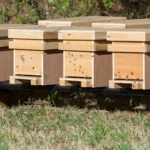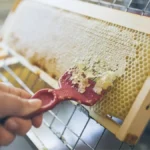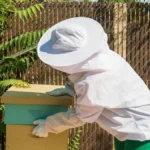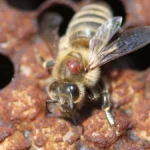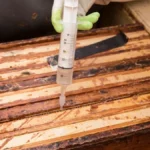Are bee skeps illegal? Well, this depends on where you are and what the laws are. These ancient beehives are a part of our cultural treasure, and are a topic we should definitely explore further!
What Is A Bee Skep Hive?
A Skep hive is a very simple hive that is made out of basketwork. In the old Norse language, a skeppa was a basket. These have been used for at least 2000 years in various parts of the world for beekeeping. Various incarnations of these things exist – in some cases the basket is coated with mud, or manure to create a waterproof enclosure for the bees.
In more recent times, people learned first to weave a rope-like material, and then coil that around in larger and larger circles to create the skep we all recognize. For many people who know little about bees, the shape of a skep hive is instantly recognizable as being a “beehive”.
Skep hives evolved over the 2000 or so years that they have been used. The basic skep hive is a meringue-shaped basket in which bees build a nest. The basket fills up with brood and combs over a season and then the entire hive is harvested going into fall. The brood and brown combs were used for making mead and the white combs for honey. This has a negative effect on the bees as the bees were killed each season. When Europe had small populations of humans and lots of forests, you could always count on wild bee swarms being around to fill skeps in spring. As human populations grew, forests declined and this system of killing bees become unsustainable and beekeepers looked at ways to produce honey that did not involve the complete destruction of the bees.
More advanced skeps became common which consisted of a basic basket with the bees in – the top of this basket had a hole, and another basket was placed over this. The bees would move into this basket and store honey. In this way the second basket could be removed, honey harvested and the hive could remain relatively intact and survive.

Learn more about: How Far Apart Should Beehives Be Placed?
Why Don’t We See Skep Hives Anymore?
There are still places in the world where people keep skep hives. The series of knee-jerk responses that regulatory authorities placed to try and control the spread of tracheal mite, and then varroa mite required that hives had to be inspected. This resulted in beekeepers being forced to use chemical control methods to control varroa mite numbers in beehives. It is a well-documented fact that the use of chemical treatments for pests delays the onset of natural immunity to pests, and enriches those that sell the chemicals. Chemical treatments should ideally not be used prophylactically, but rather symptomatically. This is why the most progress in the evolution of resistance to varroa has been made in bee populations with the least human management.
The above reasons are one of the reasons people often ask “Are bee skeps illegal?” They have heard something something something about an inspection.
As natural immunity develops in European bee populations, there are increasing groups of gorilla beekeepers who buck inspection and just keep bees the old way. This may seem anarchic(Are bee skeps illegal? – do bees care?), but the selection of natural genetics that actually resists varroa is probably the single most powerful tool for combatting the varroa mite – a large industry now exists however to “treat” varroa, and delay the onset of natural resistance. These sorts of knee-jerk responses are evident in many different problems in the world. Enhanced evolution of resistance will always be a better choice than medication to prevent the evolution of resistance by taking the problem away temporarily.
I believe that skep beekeeping will, as varroa resistance becomes more widespread, become a healthy, safe, traditional way of keeping bees that is not capital intensive, is aesthetically pleasing, and allows bees to live in urban spaces. With time I hope that people will stop asking “Are bee skeps illegal?” and be able to embrace their heritage again.
But at the present time, most states have laws in place that require that beehives need to be “inspectable” to allow the management of bee diseases. This management strategy will with time change as we learn how to better manage infectious and parasitic agents on our planet.
Why Are Skeps Cool?
Beeswax is a fatty waxy compound. This means that anything that is lipophilic will dissolve in it. Lipophilic compounds are those that are attracted to be dissolved in fats and not water. Most pesticides are lipophilic – this is because pesticides target insect nerves, and also have to penetrate the waxy layer covering an insect. Beeswax consequently enriches poisons out of the honey into the wax. A specific group of worrying pesticides is the neonicotinoids.
We are all exposed to poisons from the environment constantly. In most cases, in low doses, our bodies can degrade these – in higher doses they cannot. If you imagine an old Langstroth beehive. It has been working hard for 10 years and is full of a relatively old comb. This has been recycled into the wax and the wax made back into the foundation. The foundation is returned. We end up with a problem – pesticides build up in beeswax, and beeswax sticks around in hives for a very long time!!
How Long Can Beeswax Be Recycled and What Does This Mean For Langstroth Hives?
Beeswax is like gold – it is expensive – and very recycled. Most commercial beekeepers will render old combs to recover wax. This wax is then recycled into the foundation that goes into new frames. After a while, this wax will be recycled, and so on. It is entirely likely that in modern operations comprising thousands of hives, 10-20% of the wax in circulation is at least 50 years old. In some cases, this wax could be 70-80 years old and still be used by the bees. Bees repair wax and rework it. Some of the wax will be mixed into propolis, and this also cycles through the hives and ecosystem.
Summary – Langstroth beekeeping causes the wax to linger in hives and accumulate poisons. Poisons are bad for bees, and bad for us. (The most commonly used Varroa medication is lipophilic)
Why Skeps and Warre Hives Represent A Safe Way To Avoid The Accumulation Of Lipophilic Compounds In Wax
In Skeps and Warre hives we do not use foundation. All wax produced in the hive is virgin wax made by the bees. We remove this wax, remove honey, and then find useful things to do with the wax, such as making our own soap, hair products, face creams, candles, etc.
I am a mead maker. In fact, I have a Ph.D. in mead making and have been promoting mead making, and export of mead for three decades. You can buy my mead here. Mead is an interesting use for honey because it is fun AND yeast breaks down pesticide residues in honey. This does not matter for my mead because I use organic pesticide-free honey – but if you happen to be in a part of the world where pollution is a problem, making mead with yeast for fermentation will in fact help to degrade residues in your honey. And of course, it removes sugar which is worse for you in moderation than alcohol is.
I hope this article has helped you see how cool skep hives are! If you can use one, definitely try! And if you cannot use one, but have one for decoration somewhere and bees happen to move into it of their own choice – well – a wild hive is not property so it is not breaking any laws and it may even be helping to select for naturally disease-resistant bees! If you enjoyed this article please share!
FAQs
1. Are bee skeps illegal in the United States?
Bee skeps are not outright illegal in the U.S., but they are prohibited in many states due to inspection regulations. Modern beekeeping laws often require that hives be inspectable for diseases like varroa mites, which is difficult with skeps since they don’t have removable frames.
2. Why are bee skeps not commonly used anymore?
Bee skeps fell out of favor because they make it difficult to inspect and manage bees for diseases. Skeps also involve more destructive practices, where the entire hive is sometimes harvested, killing the bees. The Langstroth hive, which allows for removable frames and non-destructive harvesting, is now the standard.
3. What is a bee skep hive made of?
A bee skep hive is typically made of woven straw or similar materials, often shaped like a dome or basket. The design is simple but effective for bees to build their nests.
4. Can I legally keep bees in a skep in Europe?
In some European countries, skep beekeeping is still practiced, especially in rural or traditional contexts. However, similar to the U.S., the laws often require hives to be inspectable to manage disease, making skeps less common in regulated areas.
5. Do skep hives promote better bee health compared to modern hives?
Skep hives can promote healthier bees in some respects by encouraging more natural behaviors. However, they also limit the beekeeper’s ability to inspect for pests and diseases, which may lead to higher colony loss without intervention.
6. Why are skeps considered part of cultural heritage?
Skeps have been used for thousands of years and are a symbol of traditional beekeeping. They are iconic in many cultures, often represented as the typical “bee hive” shape in art and folklore.
7. Can I keep a decorative skep on my property if bees move in naturally?
In many places, you can keep a decorative skep if a wild colony of bees takes up residence. Since it was not intentionally placed for bee management, it may not be subject to the same inspection laws.
8. What are the advantages of skeps over modern hives like the Langstroth?
The main advantage of skeps is their simplicity and traditional use. They require fewer materials and can be made from natural, locally sourced products. However, modern hives provide more efficiency in honey production and hive management.
9. Are there any exceptions to laws prohibiting skep hives?
Some states or countries may allow skeps if they are used for educational or demonstration purposes, especially if no honey is being harvested or the bees are not intended for commercial use.
10. What is the environmental impact of using skeps?
Using skeps can have a lower environmental footprint since they don’t rely on manufactured frames or foundations. However, they make disease management and chemical use difficult, which can lead to colony losses that affect local ecosystems.

Dr. Garth A. Cambray is a Canadian/South African entrepreneur and beekeeper with 28 years of experience in apiculture and specializes in adding value to honey. His Ph.D. research developed a new advanced continuous fermentation method for making mead that has resulted in a number of companies globally being able to access markets for mead. His company, Makana Meadery, exports honey mead to the USA where it is available to discerning connoisseurs. He has also developed technologies to commercially manufacture organic honey vinegar in Zambia for export globally. He holds a few patents globally in the ethanol industry and believes in technology and knowledge transfer for human development and environmental sustainability. One of his proudest achievements is the fact that the wind farm he started at one of his old apiary sites has essentially made his hometown carbon neutral.

